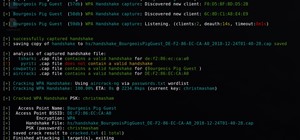Hello , just wanted to share with you some python tools I made and wanted to know your opinion on them...
https://github.com/WireWise
One is a hasher with multiple hashing algorithms the other is an AES encryption program.
Thank you.

Hello , just wanted to share with you some python tools I made and wanted to know your opinion on them...
https://github.com/WireWise
One is a hasher with multiple hashing algorithms the other is an AES encryption program.
Thank you.
 Forum Thread:
Whatsapp Hack?
16
Replies
Forum Thread:
Whatsapp Hack?
16
Replies Forum Thread:
How to Track Who Is Sms Bombing Me .
4
Replies
Forum Thread:
How to Track Who Is Sms Bombing Me .
4
Replies Forum Thread:
Removing Pay-as-You-Go Meter on Loan Phones.
1
Replies
Forum Thread:
Removing Pay-as-You-Go Meter on Loan Phones.
1
Replies Forum Thread:
Hydra Syntax Issue Stops After 16 Attempts
3
Replies
Forum Thread:
Hydra Syntax Issue Stops After 16 Attempts
3
Replies Forum Thread:
moab5.Sh Error While Running Metasploit
17
Replies
Forum Thread:
moab5.Sh Error While Running Metasploit
17
Replies Forum Thread:
Execute Reverse PHP Shell with Metasploit
1
Replies
Forum Thread:
Execute Reverse PHP Shell with Metasploit
1
Replies Forum Thread:
Install Metasploit Framework in Termux No Root Needed M-Wiz Tool
1
Replies
Forum Thread:
Install Metasploit Framework in Termux No Root Needed M-Wiz Tool
1
Replies Forum Thread:
Hack and Track People's Device Constantly Using TRAPE
35
Replies
Forum Thread:
Hack and Track People's Device Constantly Using TRAPE
35
Replies Forum Thread:
When My Kali Linux Finishes Installing (It Is Ready to Boot), and When I Try to Boot It All I Get Is a Black Screen.
8
Replies
Forum Thread:
When My Kali Linux Finishes Installing (It Is Ready to Boot), and When I Try to Boot It All I Get Is a Black Screen.
8
Replies Forum Thread:
HACK ANDROID with KALI USING PORT FORWARDING(portmap.io)
12
Replies
Forum Thread:
HACK ANDROID with KALI USING PORT FORWARDING(portmap.io)
12
Replies Forum Thread:
Hack Instagram Account Using BruteForce
208
Replies
Forum Thread:
Hack Instagram Account Using BruteForce
208
Replies Forum Thread:
Metasploit reverse_tcp Handler Problem
47
Replies
Forum Thread:
Metasploit reverse_tcp Handler Problem
47
Replies Forum Thread:
How to Train to Be an IT Security Professional (Ethical Hacker)
22
Replies
Forum Thread:
How to Train to Be an IT Security Professional (Ethical Hacker)
22
Replies Metasploit Error:
Handler Failed to Bind
41
Replies
Metasploit Error:
Handler Failed to Bind
41
Replies Forum Thread:
How to Hack Android Phone Using Same Wifi
21
Replies
Forum Thread:
How to Hack Android Phone Using Same Wifi
21
Replies How to:
HACK Android Device with TermuX on Android | Part #1 - Over the Internet [Ultimate Guide]
177
Replies
How to:
HACK Android Device with TermuX on Android | Part #1 - Over the Internet [Ultimate Guide]
177
Replies How to:
Crack Instagram Passwords Using Instainsane
36
Replies
How to:
Crack Instagram Passwords Using Instainsane
36
Replies Forum Thread:
How to Hack an Android Device Remotely, to Gain Acces to Gmail, Facebook, Twitter and More
5
Replies
Forum Thread:
How to Hack an Android Device Remotely, to Gain Acces to Gmail, Facebook, Twitter and More
5
Replies Forum Thread:
How Many Hackers Have Played Watch_Dogs Game Before?
13
Replies
Forum Thread:
How Many Hackers Have Played Watch_Dogs Game Before?
13
Replies Forum Thread:
How to Hack an Android Device with Only a Ip Adress
55
Replies
Forum Thread:
How to Hack an Android Device with Only a Ip Adress
55
Replies How To:
Make Your Own Bad USB
How To:
Make Your Own Bad USB
 How To:
Dox Anyone
How To:
Dox Anyone
 How To:
Find Identifying Information from a Phone Number Using OSINT Tools
How To:
Find Identifying Information from a Phone Number Using OSINT Tools
 How To:
Run USB Rubber Ducky Scripts on a Super Inexpensive Digispark Board
How To:
Run USB Rubber Ducky Scripts on a Super Inexpensive Digispark Board
 How To:
Automate Wi-Fi Hacking with Wifite2
How To:
Automate Wi-Fi Hacking with Wifite2
 How To:
Crack Password-Protected Microsoft Office Files, Including Word Docs & Excel Spreadsheets
How To:
Crack Password-Protected Microsoft Office Files, Including Word Docs & Excel Spreadsheets
 How To:
Scan for Vulnerabilities on Any Website Using Nikto
How To:
Scan for Vulnerabilities on Any Website Using Nikto
 How to Hack Wi-Fi:
Stealing Wi-Fi Passwords with an Evil Twin Attack
How to Hack Wi-Fi:
Stealing Wi-Fi Passwords with an Evil Twin Attack
 How To:
Use the Buscador OSINT VM for Conducting Online Investigations
How To:
Use the Buscador OSINT VM for Conducting Online Investigations
 How To:
Top 10 Things to Do After Installing Kali Linux
How To:
Top 10 Things to Do After Installing Kali Linux
 How To:
Use SpiderFoot for OSINT Gathering
How To:
Use SpiderFoot for OSINT Gathering
 Become an Elite Hacker Part 4:
Hacking a Website. [Part 1]
Become an Elite Hacker Part 4:
Hacking a Website. [Part 1]
 How To:
Easily Detect CVEs with Nmap Scripts
How To:
Easily Detect CVEs with Nmap Scripts
 How To:
Hack WPA & WPA2 Wi-Fi Passwords with a Pixie-Dust Attack Using Airgeddon
How To:
Hack WPA & WPA2 Wi-Fi Passwords with a Pixie-Dust Attack Using Airgeddon
 How To:
Use Pupy, a Linux Remote Access Tool
How To:
Use Pupy, a Linux Remote Access Tool
 How To:
Wardrive on an Android Phone to Map Vulnerable Networks
How To:
Wardrive on an Android Phone to Map Vulnerable Networks
 How To:
Scan Websites for Potential Vulnerabilities Using the Vega Vulnerability Scanner in Kali Linux
How To:
Scan Websites for Potential Vulnerabilities Using the Vega Vulnerability Scanner in Kali Linux
 How To:
Gain Complete Control of Any Android Phone with the AhMyth RAT
How To:
Gain Complete Control of Any Android Phone with the AhMyth RAT
 How To:
Change a Phone's Coordinates by Spoofing Wi-Fi Geolocation Hotspots
How To:
Change a Phone's Coordinates by Spoofing Wi-Fi Geolocation Hotspots
 How To:
Spy on Network Relationships with Airgraph-Ng
How To:
Spy on Network Relationships with Airgraph-Ng
11 Responses
I'm not a Python programmer but could you kindly explain to me as to how you generate the random IV and key for your AES encryption?
This line: ''.join(<square bracket>random.choice(string.ascii_letters + string.digits) for n in range(8)<square bracket>) means this:
for each element in range 0-7 (Range(n) returns a list of 0:n-1) choose a random element from a string of letters and digits, and append it to a list. Then join all elements of the list with the separator '' (no separator).
Random.new().read(16), which generates the IV, returns 16 random bytes.
There is a reason why dontrustme asked that question.
EDIT: Nope, never mind, I misunderstood.
So is this Random function the typical pseudo-random number generator?
nice contribution. I would prefer if you made your article more enjoyable to the eye, because it doesnt look of much at the moment.
A picture on your article, and some more in-depth explaining on your tools would be a great bonus.
Ill try my best! When I start and finish CryptoBirdv2.0, I'll add more depth, and some pictures . Thanks for help ! I'll me making more tools so if you guys have any suggestions , Ill try to make the tool you ask for.
Yes @dontrustme Random is the pseudo-random number generator for python3.4 .
From the Python 3 Documentation for random, "... being completely deterministic, it is not suitable for all purposes, and is completely unsuitable for cryptographic purposes.".
It then states: "Warning: The pseudo-random generators of this module should not be used for security purposes. Use os.urandom() or SystemRandom if you require a cryptographically secure pseudo-random number generator."
Yes but that is the IV(initialization vector) which does not have to be a secret, but if you want ill change it to os.urandom() :D let me know !
Ah, I see. Thanks for clearing that up.
Ill have everything written in detail when I release CryptoBird v2.
Share Your Thoughts